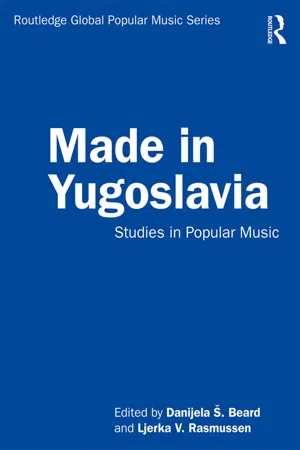1
Networking Zabavna Muzika
Singers, Festivals, and Estrada
Jelena Arnautović
The umbrella term zabavna muzika/glazba1 (mainstream popular music; lit. “entertainment” music) emerged in 1950s Yugoslavia, designating a homegrown form of Western-style popular music. According to Godišnjak RTB (the Yearbook of Radio Television Belgrade 1960, 39–40), the term zabavna muzika was introduced by Yugoslav radio stations in order to distinguish entertainment genres from ozbiljna (art music; lit. “serious”) and narodna (folk) music. Until the 1960s, the zabavna label was used rather arbitrarily to denote a variety of vocal and dance music genres, film music, jazz, operettas, and arrangements of international folk songs. This practice continued the pre-war custom of Radio Belgrade, who used the term “light music” for all types of genres considered entertainment that did not require “great concentration” and were “light, cheerful, almost insignificant pieces that one could listen to ‘with one ear’ ” (Radio-Beograd 1936, 1).
The stylistic variety of Yugoslav zabavna music was particularly pronounced during the early post-WWII years: genres derived from German, Italian, French, Russian, and American models included šlager (Schlager), kancona (canzone), šansona (chanson), romansa (romance), and evergrin (evergreen). Singers like Domenico Modugno and Charles Aznavour held particular appeal for audiences and aspiring singers. The first original songs emerging in the mid-1950s were characterized by simple, tender, and appealing melodies, with lyrics based on sentimental love stories. This ballad-style singing accompanied by an orchestra became known as domestic šlager (from Gr. Schlager). Cultural commentators and even politicians of the day had numerous discussions about the “ideal” style of Yugoslav popular music, some arguing that it must be neither too Western or bourgeois, nor too “folky” or Balkan, while others insisted that it must be neither “boring” nor “erotic” (Buhin 2016, 156). In other words, zabavna music had to be a uniquely domestic product, a form of entertainment that would reflect the “progressive foundations” (napredne osnove) of Yugoslavia’s socialist culture (Marković 1995, 392).
The institutional infrastructure for zabavna music developed rapidly from the 1960s throughout Yugoslavia, primarily with the inception of festivals dedicated to zabavna music, bolstered by strong state support from national radio and television networks. Record companies, which produced festival programs, promoted individual singers and secured the growth of a viable commercial market for domestic popular music. As a result, the festivals of zabavna music became a central hub for networking singers, songwriters, broadcasters, and record producers, and laid the foundation for the development of a national zabavna scene in the 1960s. Over the next two decades, zabavna music was transformed into a fully-fledged national estrada (music entertainment industry), providing an economic livelihood to composers, performers, media, and festival organizers alike.
“The Golden Age”: Festivals and the First Music Stars in the 1950s and the 1960s
The main venues where popular music could be heard in postwar Yugoslavia were igranke (dance-entertainment events), which were held in popular student clubs (including Božidarac and Mažestik in Belgrade), and at open public spaces such as sports stadiums. In order to tailor for the diverse audiences, igranke included medleys of revolutionary songs and dance folk music from different Yugoslav regions, alongside foreign popular songs and the latest arrangements of American dance tunes. At the time, all music performed had to be in accordance with the Communist Party’s official line on popular culture, which in the 1950s implied a “lukewarm” attitude toward the West, and especially the United States. As a result, songs imported from abroad were modified for domestic use in the form of cover versions, so-called prepevi/prepjevi, whose lyrics were translated into the Serbo-Croatian language. The vast majority of songs performed before the 1960s under the label zabavna were not original songs but rather simple adaptations of foreign songs, and even in the 1960s, many zabavna hits followed this trend (for example, Miki Jevremović’s “Kuća izlazećeg sunca” [The House of the Rising Sun, 1964] or “Zbogom Kalifornijo” [California Dreaming, 1966]).
The growth of zabavna music as a distinctive genre began with local authors composing original songs in native languages (Slovenian/Serbo-Croatian), most notably Darko Kraljić, who was the first successful and most prolific songwriter.2 He rose to fame with the songs “Zvižduk u 8” (Whistle at 8, 1959), recorded by the then hugely popular singer Đorđe Marjanović (who also played the lead role in the 1962 movie Zvižduk u 8), and “Devojko mala” (Hey, Little Girl, 1958), sung by the actor Vlastimir Đuza Stojiljković in the musical comedy Ljubav i moda (Love and Fashion, 1960). Alongside Kraljić, several other songwriters started composing zabavna songs in the 1950s: Milan Kotlić, Dušan Vidak, Mladen Guteša, Aca Nećak, Bojan Adamič, Ljubo Kuntarić, Žarko Petrović, and Dragomir Ristić.3 The pioneering careers of the singers who became indentified with the genre (in Serbia, for example, Vojin Popović, Voja Milanović, Mara Petrović, Olga Nikolić, Olivera Marković, sisters Jeftić) were launched through Yugoslav radio programs, accompanied by radio orchestras that performed both zabavna and jazz music, including Plesni orkestar Radio Ljubljane (The Dance Orchestra of Radio Ljubljana, founded in 1945), Plesni orkestar Radio Zagreba (The Dance Orchestra of Radio Zagreb, founded in 1946), and Zabavni orkestar Radio Beograda (The Entertainment Orchestra of Radio Belgrade, founded in 1948; renamed The Jazz Orchestra in 1960).
Political opening toward the West in the 1960s led to greater opportunities for artists, which included the founding of new cultural and educational institutions, rapid media development, and a general blossoming of cultural life. The early socialist ideals, such as modesty and collectivism, were now overshadowed by popular singers who introduced glamorous Western lifestyles as new aspirational models for Yugoslav citizens to follow (see Marković 1995, 417–24). Numerous festivals of “light music” (lakih nota) were launc...
